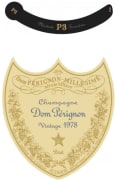Champagne Wine France 1 Items

- Non-Vintage 1034
- 2020 2
- 2019 11
- 2018 22
- 2017 18
- 2016 48
- 2015 76
- 2014 71
- 2013 83
- 2012 114
- 2011 42
- 2010 57
- 2009 100
- 2008 135
- 2007 71
- 2006 125
- 2005 74
- 2004 122
- 2003 37
- 2002 92
- 2001 6
- 2000 73
- 1999 55
- 1998 40
- 1997 17
- 1996 47
- 1995 64
- 1994 9
- 1993 26
- 1992 14
- 1991 3
- 1990 47
- 1989 20
- 1988 25
- 1986 6
- 1985 15
- 1983 4
- 1982 7
- 1981 4
- 1980 1
- 1979 5
- 1978 clear Vintage filter
- 1973 1
- 1955 1
-
Gift Type Any
-
Occasion Any
-
Variety Any
-
Varietal Any
-
Region Champagne
-
Availability Include Out of Stock
-
Size & Type Any
-
Fine Wine Any
-
Vintage 1978
-
Reviewed By Any
-
Sort By Most Interesting
-
Dom Perignon P3 Plenitude 1978Vintage Sparkling Wine from Champagne, France0.0 0 RatingsSold Out - was $1,812.99Ships Mon, Jan 1Limit 0 per customerSold in increments of 0
Browse by Category
Red White Sparkling Rosé Spirits GiftsLearn about Champagne, common tasting notes, where the region is and more ...
Associated with luxury, celebration, and romance, the region, Champagne, is home to the world’s most prized sparkling wine. In order to bear the label, ‘Champagne’, a sparkling wine must originate from this northeastern region of France—called Champagne—and adhere to strict quality standards. Made up of the three towns Reims, Épernay, and Aÿ, it was here that the traditional method of sparkling wine production was both invented and perfected, birthing a winemaking technique as well as a flavor profile that is now emulated worldwide.
Well-drained, limestone and chalky soil defines much of the region, which lend a mineral component to its wines. Champagne’s cold, continental climate promotes ample acidity in its grapes but weather differences from year to year can create significant variation between vintages. While vintage Champagnes are produced in exceptional years, non-vintage cuvées are produced annually from a blend of several years in order to produce Champagnes that maintain a consistent house style.
With nearly negligible exceptions, . These can be blended together or bottled as individual varietal Champagnes, depending on the final style of wine desired. Chardonnay, the only white variety, contributes freshness, elegance, lively acidity and notes of citrus, orchard fruit and white flowers. Pinot Noir and its relative Pinot Meunier, provide the backbone to many blends, adding structure, body and supple red fruit flavors. Wines with a large proportion of Pinot Meunier will be ready to drink earlier, while Pinot Noir contributes to longevity. Whether it is white or rosé, most Champagne is made from a blend of red and white grapes—and uniquely, rosé is often produce by blending together red and white wine. A Champagne made exclusively from Chardonnay will be labeled as ‘blanc de blancs,’ while ones comprised of only red grapes are called ‘blanc de noirs.’

